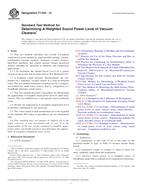Potrebujeme váš súhlas na využitie jednotlivých dát, aby sa vám okrem iného mohli ukazovať informácie týkajúce sa vašich záujmov. Súhlas udelíte kliknutím na tlačidlo „OK“.
ASTM E2863-12
Standard Practice for Acoustic Emission Examination of Welded Steel Sphere Pressure Vessels Using Thermal Pressurization
Automaticky preložený názov:
Štandardné praktiky pre akustické emisie kontrolou zváraných oceľovou guľou tlakových nádobách použitie tepelnej natlakovanie
NORMA vydaná dňa 15.6.2012
Informácie o norme:
Označenie normy: ASTM E2863-12
Poznámka: NEPLATNÁ
Dátum vydania normy: 15.6.2012
Kód tovaru: NS-46168
Počet strán: 7
Približná hmotnosť: 21 g (0.05 libier)
Krajina: Americká technická norma
Kategória: Technické normy ASTM
Kategórie - podobné normy:
Hluk působený stroji a zařízeními
Tlakové nádoby, plynové lahve
Anotácia textu normy ASTM E2863-12 :
Keywords:
acoustic emission, corrosion, flaws, HALON 1301, steel, ICS Number Code 17.140.20 (Noise emitted by machines and equipment), 23.020.30 (Pressure vessels, gas cylinders)
Doplňujúce informácie
| Significance and Use | ||||||||||||||||||
|
Because of safety considerations, regulatory agencies (for example, U.S. Department of Transportation) require periodic tests of pressurized vessels used in commercial aviation. (see Section 49, Code of Federal Regulations). AE esting has become accepted as an alternative to the common hydrostatic proof test. An AE test should not be conducted for a period of one year after a common hydrostatic test. See Note 1. Note 1—The Kaiser effect relates to the irreversibility of acoustic emission which results in decreased emission during a second pressurization. Common hydrostatic tests use a relatively high test pressure (200 % of normal service pressure). (See Section 49, Code of Federal Regulations.) If an AE test is performed too soon after such a hydrostatic pressurization, the AE results will be insensitive below the previous maximum test pressure. Acoustic Emission is produced when an increasing stress level in a material causes crack growth in the material or stress related effects in a corroded surface (for example, crack growth in or between metal crystallites or spalling and cracking of oxides and other corrosion products). While background noise may distort AE data or render it useless, heating the vessels inside an industrial oven is an almost noise free method of pressurization. Further, source location algorithms using over-determined data sets will often allow valid tests in the presence of otherwise interfering noise sources. Background noise should be reduced or controlled but the sudden occurrence of such noise does not necessarily invalidate a test. |
||||||||||||||||||
| 1. Scope | ||||||||||||||||||
|
1.1 This practice is commonly used for periodic inspection and testing of welded steel gaseous spheres (bottles) is the acoustic emission (AE) method. AE is used in place of hydrostatic volumetric expansion testing. The periodic inspection and testing of bottles by AE testing is achieved without depressurization or contamination as is required for hydrostatic volumetric expansion testing. 1.2 The required test pressurization is achieved by heating the bottle in an industrial oven designed for this purpose. The maximum temperature needed to achieve the AE test pressure is ≤250°F (121°C). 1.3 AE monitoring of the bottle is performed with multiple sensors during the thermal pressurization. 1.4 This practice was developed for periodic inspection and testing of pressure vessels containing Halon (UN 1044), which is commonly used aboard commercial aircraft for fire suppression. In commercial aircraft, these bottles are hermetically sealed by welding in the fill port. Exit ports are opened by explosively activated burst disks. The usage of these pressure vessels in transportation is regulated under US Department of Transportation (DOT), Code of Federal Regulations CFR 49. A DOT special permit authorizes the use of AE testing for periodic inspection and testing in place of volumetric expansion and visual inspection. These bottles are spherical with diameters ranging from 5 to 16 in. (127 to 406 mm). 1.5 The values stated in inch-pound units are to be regarded as the standard. The values given in parentheses are mathematical conversions to SI units that are provided for information only and are not considered standard. 1.6 This standard does not purport to address all of the safety concerns, if any, associated with its use. It is the responsibility of the user of this standard to establish appropriate safety and health practices and determine the applicability of regulatory limitations prior to use. Specific precautionary statements are given in Section 8. |
||||||||||||||||||
| 2. Referenced Documents | ||||||||||||||||||
|
Podobné normy:
Historická
1.4.2009
Historická
15.6.2012
Historická
1.1.2010
Historická
15.6.2012
Historická
1.8.2014
Historická
1.4.2014
Odporúčame:
Aktualizácia technických noriem
Chcete mať istotu, že používate len platné technické normy?
Ponúkame Vám riešenie, ktoré Vám zaistí mesačný prehľad o aktuálnosti noriem, ktoré používate.
Chcete vedieť viac informácií ? Pozrite sa na túto stránku.



 ASTM E596-96(2009)..
ASTM E596-96(2009).. ASTM E749/E749M-12..
ASTM E749/E749M-12.. ASTM E750-10
ASTM E750-10 ASTM E751/E751M-12..
ASTM E751/E751M-12.. ASTM F1334-14
ASTM F1334-14 ASTM F1797-14
ASTM F1797-14
 Cookies
Cookies
